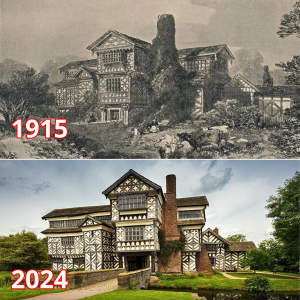
Nestled in the lush countryside of Cheshire, Little Moreton Hall stands as a testament to the enduring beauty and craftsmanship of Tudor architecture. This iconic half-timbered manor house has captivated visitors for centuries, with its charming crooked lines, ornate woodwork, and picturesque setting. As we take a closer look at Little Moreton Hall, comparing photographs from 1915 with its present-day appearance, we gain a deeper appreciation for the preservation efforts that have kept this historic gem intact for over 500 years.
The History of Little Moreton Hall

Little Moreton Hall, also known as Old Moreton Hall, was built between 1504 and 1610 by the affluent Moreton family. The Hall is a quintessential example of timber-framed architecture, a style that flourished in England during the Tudor period. Its construction features a distinctive “black and white” design, with dark oak beams contrasting against white plaster. The Hall’s eccentric, uneven structure is a result of the wooden frame warping over time, giving it a unique and whimsical appearance.
The Moreton family, who had been influential landowners in the area for generations, lived in the Hall for over 400 years. However, by the early 20th century, the estate had fallen into disrepair, and the family faced financial difficulties. In 1912, Little Moreton Hall was leased to the National Trust, which later purchased the property outright in 1938. Since then, the National Trust has overseen extensive restoration efforts to preserve the Hall for future generations.
Little Moreton Hall in 1915

In 1915, Little Moreton Hall was already recognized as an architectural treasure, though it was not the bustling tourist attraction it is today. Photographs from this period depict a quieter, more secluded estate, surrounded by lush gardens and reflective moats. The Hall’s striking timber frame, with its distinctive patterns and intricate carvings, was as captivating then as it is now. However, signs of wear and age were beginning to show, with some areas of the structure in need of repair.
At that time, the Hall was still relatively untouched by modern restoration techniques, giving it an authentic, if slightly weathered, appearance. The gardens, though less meticulously maintained than today, added to the overall charm of the estate, with their informal, slightly wild character.
Little Moreton Hall Today

Fast forward to the present day, and Little Moreton Hall remains a beloved historic site, drawing visitors from around the world. Thanks to the efforts of the National Trust and dedicated conservationists, the Hall has been carefully restored and maintained, allowing it to retain its original charm while ensuring its structural integrity.
Today, visitors can explore the Hall’s many rooms, each filled with period furnishings, tapestries, and artifacts that offer a glimpse into life during the Tudor era. The uneven floors, crooked doorways, and low ceilings create an immersive experience, transporting visitors back in time.
The gardens have also undergone significant changes, with carefully designed landscapes that complement the Hall’s historic character. The moat, once a functional feature of the estate, now serves as a tranquil reflection pool, enhancing the Hall’s picturesque beauty.
Preserving the Past for the Future
The comparison between Little Moreton Hall in 1915 and today highlights the importance of preservation and restoration in maintaining our cultural heritage. While the Hall has undergone many changes over the centuries, its essence remains unchanged—a testament to the skill and artistry of those who built it and those who have worked tirelessly to preserve it.
Little Moreton Hall is more than just a building; it is a living piece of history, a connection to a bygone era that continues to inspire and captivate. As we reflect on its journey from the early 20th century to the present day, we are reminded of the value of preserving our past for future generations to explore and enjoy.





